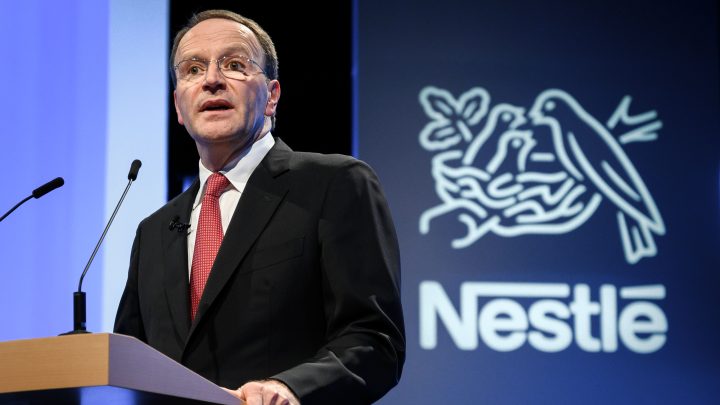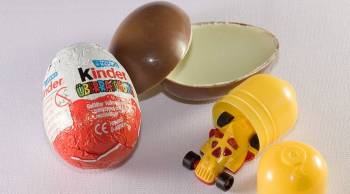
Why Nestle lost $2.1 billion on this peanut allergy cure

Nestle, the Swiss grocery giant, is famous for its Crunch bars, its coffee creamer and even its water brand. But the company’s CEO, Mark Schneider, who took the reins in 2016 after heading a German health care company, wanted to take Nestle in a new direction.
More specifically, he sold off some of the company’s confectionary brands — including its North American ice cream businesses — and moved into the trendy wellness space by buying vitamin maker Bountiful’s main brands.
Schneider’s biggest pivot for Nestle came in 2020, when the company acquired the maker of a pill that cures peanut allergies for $2.6 billion.
“It sounded like a promising investment because it was [Food and Drug Administration] approved, but in reality, it’s just peanut powder, put into capsules, and measured very, very precisely,” said Dasha Afanasieva, who covered the acquisition in Bloomberg Business Week.
But treatment with the pill, called Palforzia, takes about two years and dozens of doctor’s visits, and consumers were slow on the uptake. After writing down the value of the medication’s manufacturer by $2.1 billion, Nestle recently announced that it’s selling the company.
Marketplace host Kai Ryssdal talked to Dasha Afanasieva about her reporting on Nestle’s $2 billion misstep. The following is an edited transcript of their conversation.
Kai Ryssdal: When people think Nestle, they do not think pharmaceuticals. How did it come to pass that Nestle spent $2.5 billion on a pharmaceutical company that makes this medicine we’re talking about?
Dasha Afanasieva: You’re right. Historically, Nestle is known for things like candy bars and infant formula, but it was looking for new avenues of growth and decided that this crossover between nutrition and health and pharma was where it wanted to be, and it would be a high-growth area. So it invested in this drug, and it didn’t go very well.
Ryssdal: No, it didn’t at all, which is why we’re talking to you. First of all, explain how this drug works. Because millions of people have peanut allergies — it’s a big deal for children. Explain how this thing works that would make it such a promising investment for Nestle.
Afanasieva: So, it sounded like a promising investment because it was FDA approved. But in reality, it’s just peanut powder put into capsules, and it’s measured very, very precisely. You can give your child a little bit of this peanut powder, see how they do and gradually work them up so that peanuts aren’t really as dangerous for them.
Ryssdal: It is, though, really high touch, right? I mean, it involves a lot of effort on the part of the would-be consumer to make this medicine, Palforzia, effective.
Afanasieva: That’s right. So, it happens over two years, and it involves lots of visits to the doctor, lots of monitoring. If you’re the child, there’s lots of things you can’t do around the time when you take this treatment, because you have to keep your body temperature the same, so you’re not supposed to exercise, you’re not supposed to take hot showers. So it’s a very big commitment for both the child and the parents.
Ryssdal: Since this drug has not caught on, Nestle has said they’re going to sell it off. They’re going to write it down to the tune of something like $2 billion. One wonders whether Mark Schneider, CEO of Nestle, in trying to move the company, maybe kind of didn’t read the room on this particular investment.
Afanasieva: That’s a funny one, because he also used to be the CEO of a pharma company. So they’ve formally launched the sales process, but as you said, they’ve taken a big writedown. I think that they’re still super interested in stuff that intersects where it’s, you know, health and nutrition and that sort of stuff. But pharmaceuticals is not going to be something that Nestle invests in again, I think. Apart from this misstep, I think you’ll have to appreciate that the path to market is very different — you know, marketing to doctors and then indirectly to patients is different from selling to supermarkets.
Ryssdal: Well, let’s talk about that marketing thing for a second, right? Because it’s a totally different ballgame marketing, you know, Nespresso with George Clooney, which Nestle owns, versus a really expensive pharmaceutical.
Afanasieva: It’s super different, because with Nepresso, it’s similar in that you might be convincing somebody that they need a product, but the people you’re convincing are completely different. And regulators are different in different countries. You have all these different bodies you have to convince of both the efficacy and the cost-effectiveness of something. And then all of that has to sort of percolate through to the end consumer — and their parents, crucially — so it’s completely different to selling Kit Kats or Nespresso.
There’s a lot happening in the world. Through it all, Marketplace is here for you.
You rely on Marketplace to break down the world’s events and tell you how it affects you in a fact-based, approachable way. We rely on your financial support to keep making that possible.
Your donation today powers the independent journalism that you rely on. For just $5/month, you can help sustain Marketplace so we can keep reporting on the things that matter to you.

















